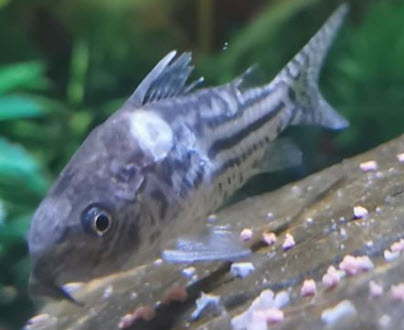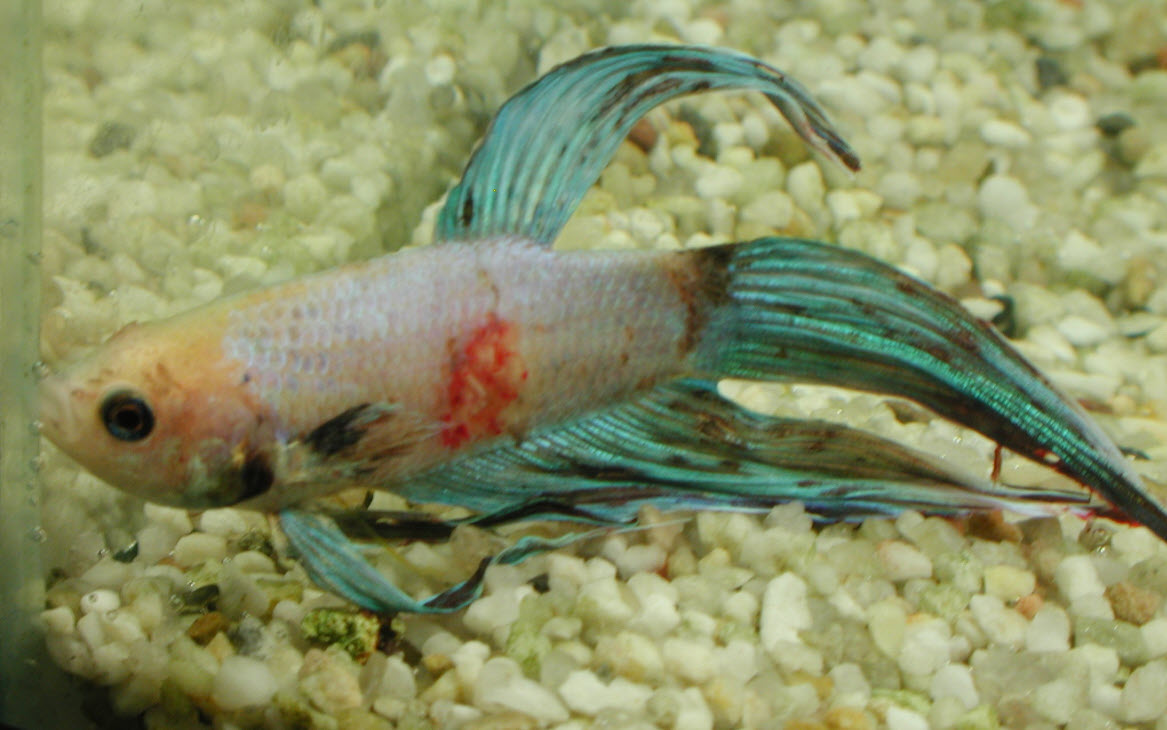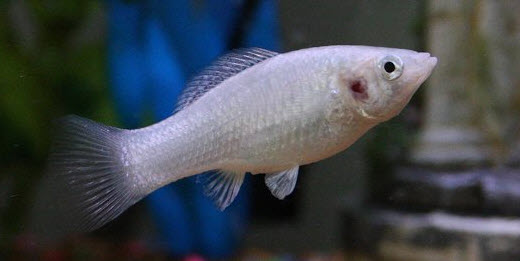There are many ways and many bacterial species which attack tropical fish in the aquarium. These diseases move much faster that other pathogens and can kill fish rapidly. It is very important to keep a stock of good antibiotics in the refrigerator to treat fish without delay. A two day wait for Amazon to get the antibiotic to one can result in many fish deaths.
Bacterial diseases come in many variations. The fish below has a huge number of bacterial diseases, including saddleback which is turning into an ulcer, fin rot, hemorrhagic septicemia, slime coat syndrome and gill disease.

Bullying and Bacteria
Another very common combination seen especially with cichlids is that the fish is both beat up and it has a host of bacterial diseases.
There are two ways this occurs:
- The fish gets a bacterial disease, the other fish realize it is weakened, and they attack the weak fish.
- The fish is attacked, weakened by the attack, and gets a host of bacterial diseases.
The exact genesis of the problem is immaterial. The affected fish needs quiet solitude alone in a hospital tank with antibiotic laced food being fed to it. This is a fish with both indications of being beat up and indications of multiple bacterial infections.

Old Age
Note that sometimes fish just get old and go into a decline with multiple bacterial infections. This is very common with bettas.

There is little that can be done for such a fish.
Types of Bacteria
There are a lot of bacteria species which can cause fish diseases. It isn’t important to know which bacteria is causing the disease (with the notable exception of popeye). In any case most of us don’t have the resources to adequately tell which bacteria species the culprit is.
Some common types include:
- Gram Negative (most common): columnaris (flavobacteria, flexibacteria), aeromonas, pseudomonas, vibrio and brucella
- Gram Positive: corynebacterium and nocardia
Bacterial diseases are generally either “external” or “internal”. The term “external” is actually somewhat of a misnomer in that most “external” bacterial infections kill the fish by attacking internally.
“External” bacterial diseases such as mouth rot, gill disease, and what is often incorrectly termed “fungus” are most often (but not always!) the bacteria Flavobacterium columnare, or “columnaris” for short. The name “columnaris” comes from the long strands or “columns” the bacteria make on the fish. This gives the infections a “fuzzy” or “cottony” look many mistake for a “fungus” (i.e. saprolegnia). Columnaris is a rapid killer of fish and can wipe out an aquarium full of fish in days.
Often the first sign of columnaris is “flashing”, where the fish rub against ornaments and substrate. But “flashing” can indicate lots of diseases so it isn’t a specific symptom. Columnaris typically then shows up in the gills as red or brown gills, i.e. “bacterial gill disease”. The fish will “gasp” for more oxygenated water. These red or brown gills are often hard to spot.
Columnaris will then move out and become mouth rot or saddleback. Often the fish’s spine will bend and the tail will drop in the water.
Other gram negative bacteria are typically responsible for the other major bacterial symptom, namely fin rot.
“Internal” bacterial disease such a hemorrhagic septicemia (“red blotch”) are generally but not always Aeromonas salmonicida, another gram negative bacteria. Whenever a fish gets hemorrhagic septicemia (“red blotch”) the bacterial infection is pretty advanced and treatment options become pretty limited. Sometimes downright draconian measures are called for to prevent mass die offs.
What is missed by many is that bacterial diseases can rapidly kill fish with no apparent symptoms on the fish. The bacteria attack the internal organs and kill the fish by organ failure. Whenever several fish die together or in rapid succession one should treat for bacterial disease.

Bacterial Infections in New Fish
In southeast Asian aquarium fish are raised by the millions in water which is permeated by cheap antibiotics. When the stressed fish get to the fish store, they tend to get bacterial infections quite easily. Fish stores don’t use antibiotics because antibiotics are very expensive in America (the government doesn’t allow cheap antibiotics to be imported, even if it is for fish use only. The drug companies and the profit motive win again!). As a result, there are a lot of fish in the big box stores that have bacterial infections.
If a fish with a patch of bacterial infection gets put into an aquarium the results can be catastrophic. The water might normally have a population of “bad” bacteria of one thousand per milligram water. The infected fish might be putting out free swimming “bad” bacteria at a rate of ten million bacteria per milligram. This overwhelms the immune systems of a whole lot of fish at once. And a massive die-off ensues.

Treatment of Bacterial Diseases
Most aquarium bacterial diseases are gram negative infections and are best hit with a broad-spectrum antibiotic effective against gram negative bacteria. They include Midland Vet Service Aqua-Mox, VetDepot Amoxicillin, Fishbiotic Ampicillin, Mardel Maracyn 2, SeaChem KanaPlex, API Fin And Body Cure.
As of June 11, 2023 the sale of these antibiotics in the USA will be prohibited without a veterinarian’s prescription. This is going to cause some real problems in the hobby.
These medications are only available over the internet. Fish stores have all gone over to “natural” medications which have a very high profit margin and simply don’t work.
Note that if antibiotics are not available, human antibiotics can be used in their place. Just grind up any pills to a fine powder. Be aware human drugs are much more potent concentrations than fish forms so only add tiny “smidgens”.
Bacterial infections are ONLY effectively treated with antibiotics in the food. Many believe (and the instructions on the antibiotics say!) that antibiotics need to be added to the water. They are simply incorrect. This controversial topic is covered in the following link:

It is easy to make medicated food. Heat 1/4 cup water (two ounces or 58 milliliters, not a lot) in the microwave. Then blend one 1/4 ounce of plain gelatin (Knox gelatin, one envelope),pectin or agar into the hot water with vigorous stirring. Take two tablespoons of dry commercial fish food (pellets or flake) and mix it with just a little of the hot water/ gelatin mixture. Add hot water/gelatin until you get a paste like consistency. If it gets too watery just add more food.
Then add just a “smidgen” (roughly 1/16 teaspoon, a 1% to 2% addition) of medication to the mud. If you are using more than one medication mix the medications together, then use just a “smidgen” of the mixture. If you are using a packet of medication, take just a “smidgen” of the packet contents. Mix and mash the whole mass thoroughly. Spread it out into a pancake about 1/8th inch (3 mm) thick on a plastic film or a plate. Then put in the refrigerator. If you plan on keeping it for more than two weeks put it in a small plastic bag and freeze.
All the fish in the aquarium should be fed a steady diet of the antibiotic laced food for at least ten days. Note that the exact amount of medication which goes into the food is not very important. Antibiotics can be overdosed pretty much with abandon as they are only toxic in large doses over a period of months. Note this gel food is 80% water. So it will require ten eyeballs per day of food per fish (six fish = 60 fish eyeballs = six times ten).

Note that antibiotics are the ONLY medications effective against bacterial diseases. There are a huge number of medications like “Fishkeeper” Natural Medication, Indian Almond Leaves, Pimafix and Melafix, etc. etc. which many claim work against bacteria. They are simply incorrect. These medications only serve to create profits for companies with creative marketing departments.
Sulfa drugs and furans can be added to the water column and will inhibit bacterial growth in the water column, much like antiseptics. But sulfa drugs and furans should not be added to the food. Adding sulfa drugs or furans to fish food CAN, in some cases, kill the fish. Sulfa drugs and furans can be used as a “nuclear option” in hemorrhagic septicemia as a one hour baths at high concentrations repeated daily and as a low concentration in the aquarium water to keep the population of the bacteria in the aquarium water low. This is done in conjunction with antibiotics in the food.
One keeper of Malawi fish with a popular YouTube channel (Ben Ochart) got columnaris in his tanks of predator haps. He tried Melafix and Pimafix. They did nothing. After having about half his gorgeous aquarium wiped out he tried broad spectrum antibiotics (Maracyn 2) in conjunction with sulfa drugs and the plague stopped.
These ineffective medications are delved into in much more depth in this link:
For more in depth analysis of antibiotics and their uses go to the link:

Types of Bacterial Diseases
Bacterial disease are rapid killers. They need rapid intervention in the form of antibiotics loaded into the food and only the food. These bacterial diseases are separated based on the most common symptoms shown in these links:
10.3.9. Bacterial Gill Disease
10.3.10. Red Mouth in Goldfish
.


